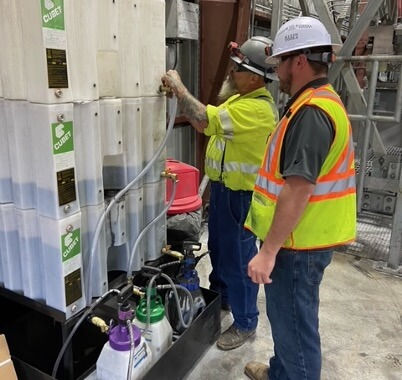Elevating Industrial Equipment Reliability through Lubrication, Oil Storage, and Contamination Control Best Practices
- davidc664
- Aug 20
- 3 min read

In industrial operations, equipment reliability isn’t just a goal; it's a necessity. Reliable machinery boosts productivity and reduces operational costs. Proper lubrication, effective oil storage, and rigorous contamination control are all critical to achieving this reliability. This post will delve into best practices in each area, offering clear and actionable tips to help enhance the performance of your industrial equipment.
Understanding the Importance of Lubrication
Lubrication plays a vital role in reducing friction and wear between moving parts. Using the right lubricant can extend the life of equipment by up to 50%, while also improving overall efficiency.
Here are effective lubrication practices you should implement:
Select the Right Lubricant: Different applications require specific types of lubricants. For example, special gear oils may be needed for worm gear gearboxes, while hydraulic fluids are inexpensive and readily available they should not be used in pumps and compressors where and R&O fluid is specified.
Proper Application: Ensure lubricants are applied at optimal levels, reducing the risk of both over-lubrication and under-lubrication. Regular lubrication intervals should follow the manufacturer's recommendations. We are a huge proponent of regular oil analysis to ensure oil changes are done when needed and not just when the calendar changes.
Training: Train your personnel on effective lubrication techniques. Regular training sessions can ensure everyone understands the importance of lubrication, which enhances equipment reliability. Your lubricant provider should offer some value-added training complimentary for their customers.
Best Practices for Oil Storage and Handling
Proper storage and handling of lubricants is essential to maintain their quality and prevent contamination.
1. Storage Conditions
Ensure lubricants are stored in a controlled environment. Keeping them away from direct sunlight and at stable temperatures prevents degradation. For example, lubricants should ideally be stored at temperatures between 60°F and 80°F.
Containers should be tightly sealed to avoid moisture and airborne particle contamination.
2. Inventory Management
Implementing a first-in, first-out (FIFO) inventory system is critical. This method ensures older products are used before new ones, which helps reduce the risk of expired lubricants and contamination. Conduct inventory checks monthly to ensure all stored lubricants are within their shelf life. Arrival dates should be applied to lubricant containers so you know when a particular oil arrive at your site.
3. Handling Procedures
Use clean tools and equipment for transferring lubricants. For instance, ensure hoses and pumps are dedicated to specific lubricants to prevent cross-contamination. Train employees to avoid using containers that have held other substances, as residues can compromise lubricants. Make sure each container is dedicated to only one type of lubricant.
Contamination Control Best Practices
Contamination is a major cause of equipment failure, making effective contamination control essential.
1. Filtration Systems
Install filtration systems within lubrication circuits to eliminate unwanted particles. Regularly replacing filters based on your equipment's operating hours—typically every 1000 hours—ensures that contaminants do not impact performance. Installing before and after pressure gages can allow you to visually see when a filter is plugged and needs to be changed.
2. Sealing and Gasketing
Quality seals and gaskets prevent outside contaminants from entering machinery. Conduct inspections every three months to check for wear. Replacing worn seals promptly can save significant costs related to equipment damage.
3. Monitoring and Testing
Routine monitoring of lubricant conditions through tests for water content, particle count, and viscosity can reveal contamination early. Consider establishing a quarterly testing schedule to catch issues before they escalate.
Training and Awareness
Investing in training programs is crucial to ensure employees understand lubrication, oil storage, and contamination control best practices. Cover how neglecting these practices can lead to failures and costly downtime.
Fostering a culture that emphasizes equipment reliability can lead to noticeable performance improvements and reduced equipment-related disruptions.
Leveraging Technology for Enhanced Reliability
In today’s high-tech world, leveraging technology is key to enhancing equipment reliability.
1. Condition Monitoring Systems
Real-time condition monitoring systems can provide data on equipment performance and lubricant health. These systems can alert staff to potential problems, enabling proactive maintenance before breakdowns occur.
2. Predictive Maintenance
Using predictive maintenance tactics allows organizations to anticipate failures through data analysis. For example, analyzing data trends can enable you to schedule maintenance during off-peak production hours, minimizing unexpected downtimes by 30%.
Crafting a Sustainable Future
Improving industrial equipment reliability involves effective lubrication, proper oil storage and handling, and strict contamination control. When organizations implement best practices in these areas, they can significantly reduce equipment failures and improve their overall productivity.
Investing in training and employing advanced technologies supports these efforts, creating a solid foundation for long-lasting equipment reliability. By prioritizing these practices today, businesses can ensure their equipment remains efficient and effective, driving greater success in their operations tomorrow.
Contant a Reliability Specialist for more information by calling 913-334-5823 or email info@indsealing.com



Comments